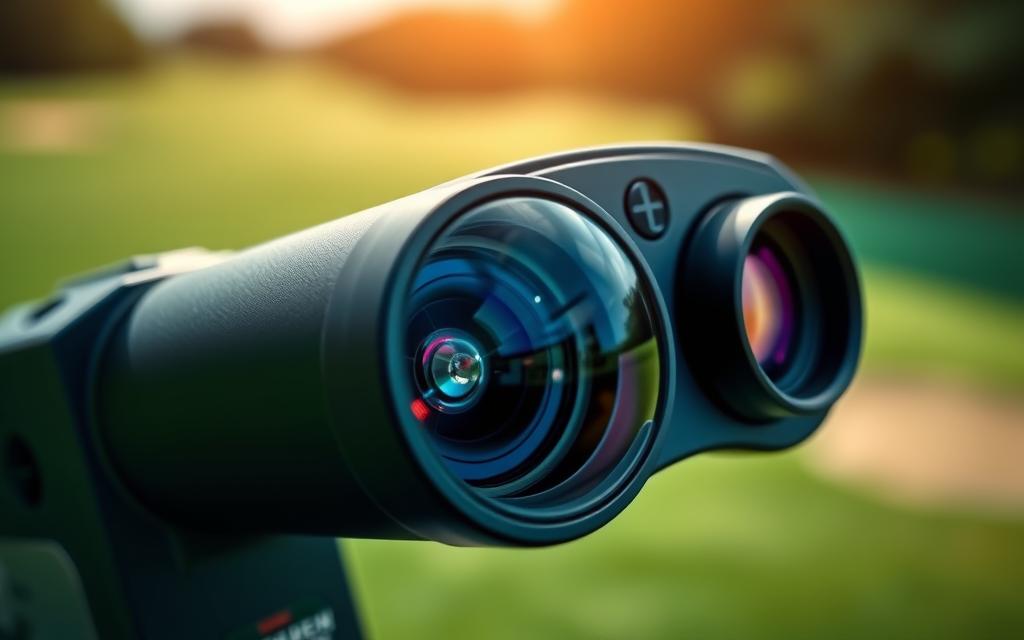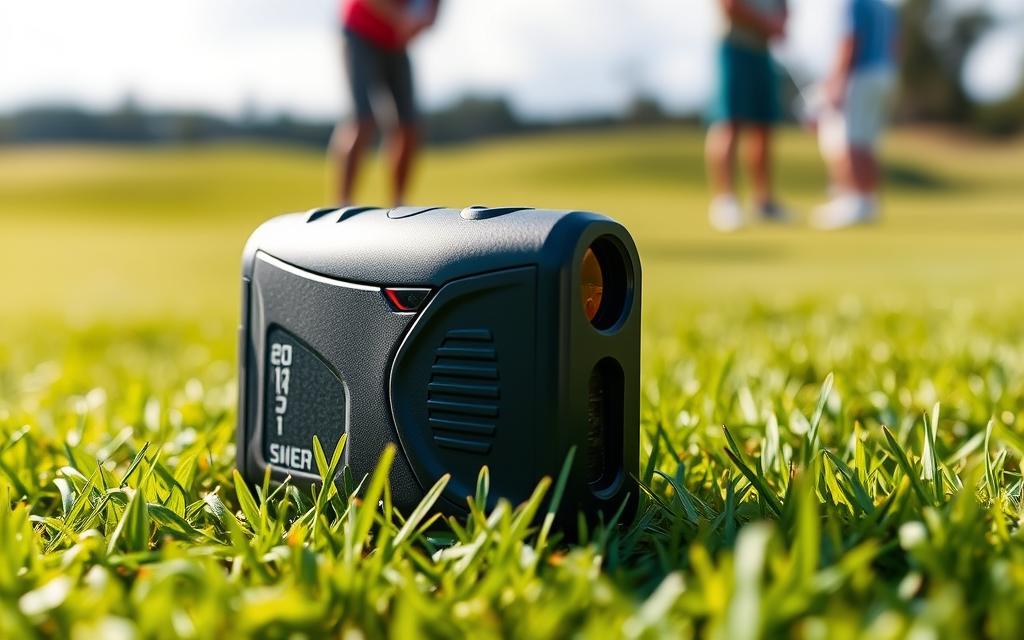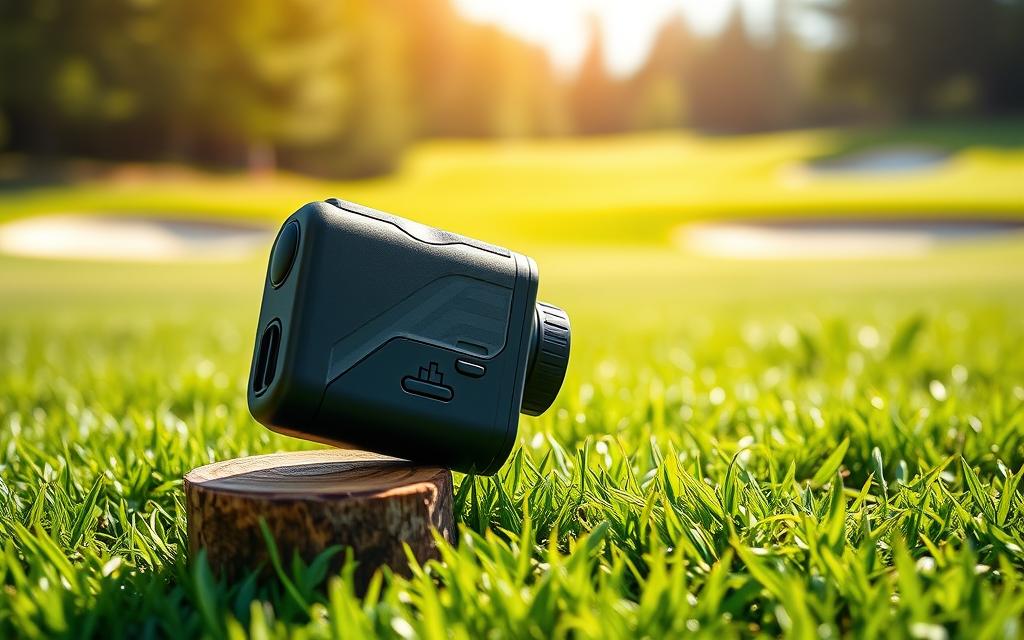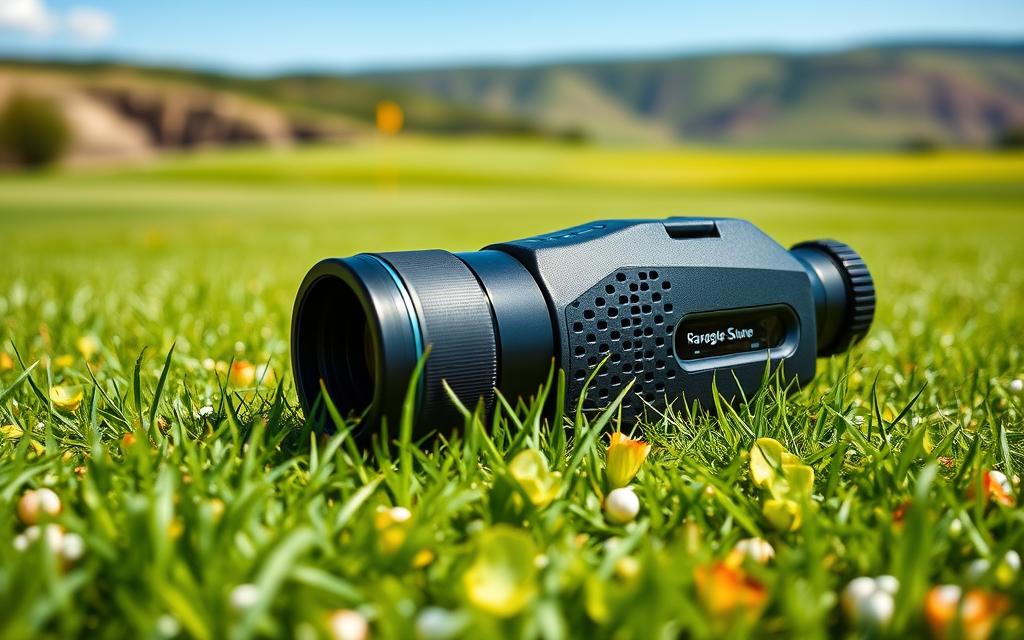Ever curious about how golf laser rangefinders give such exact distances? It’s not just about pointing and shooting. There’s a lot of cool tech and engineering behind these tools. In this guide, we’ll dive into how they work, their features, and the new trends changing golf.
Key Takeaways
- Laser rangefinders use light-based technology to accurately measure distances on the golf course
- Advanced features like slope-adjusted yardages and multi-layer targeting enhance the functionality of modern rangefinders
- Understanding the technology behind laser rangefinders can help golfers make more informed purchasing decisions and utilize these tools effectively
- Emerging trends in rangefinder design and connectivity promise even greater innovations in the future
- Proper usage and maintenance of laser rangefinders are key to ensuring reliable and long-lasting performance
Understanding the Basics of Golf Laser Rangefinders
Golf laser rangefinders are tools that help golfers measure distances. They are small but pack a lot of tech. They use golf rangefinder technology to give golfers yardage info. This helps them choose the right club and plan their game.
What is a Golf Laser Rangefinder?
A golf laser rangefinder has a laser, a receiver, and a brain. The laser shoots out a beam that hits the target. Then, the receiver catches the beam and figures out how far it is.
Key Components of a Rangefinder
The parts of a golf laser rangefinder work together. They include:
- Laser Emitter: Shoots out a beam of light.
- Receiver: Catches the beam and measures its return time.
- Optics: Rangefinder optics give a clear view of the target.
- Internal Processor: Figures out the distance and shows it to you.
Knowing how a golf laser rangefinder works shows how tech has changed golf. It helps golfers of all levels.
“Golf laser rangefinders have become an indispensable tool for players who want to optimize their performance on the course.”
The parts work together well. This makes golf laser rangefinders easy to use. They help golfers make better choices and play better.
The Technology Behind Laser Rangefinders
To get how golf laser rangefinders work, we need to look at their core tech. They use laser tech and smart algorithms. These turn laser data into exact distance numbers.
Laser Technology Explained
Laser rangefinders send out a focused light beam to find distance. This light hits a target and bounces back. The time it takes for the light to return lets the rangefinder figure out the distance.
The Role of Measurement Algorithms
The secret to rangefinder distance measurement is in the smart algorithms. They use the laser’s return time to give a precise distance. This tech and algorithms help golfers trust their rangefinder for exact yardage.

“The laser technology and algorithms in modern golf rangefinders are truly remarkable, allowing golfers to measure distances with unparalleled precision and confidence.”
How Rangefinders Measure Distance
Golf laser rangefinders use a cool tech called the time-of-flight principle. They send out a laser pulse and measure how long it takes to bounce back. This lets them figure out the exact distance with great accuracy.
The Concept of Time-of-Flight
The time-of-flight method sends a laser beam and measures its return time. It uses the speed of light to calculate the distance. This makes the distance measurement very accurate, usually within a yard or less.
Beam Divergence and Precision
Beam divergence is key to rangefinder accuracy. As the laser pulse travels, it spreads out, making the beam wider at longer distances. This can make the readings less precise. But, some rangefinders have special lenses to keep the beam tight, improving accuracy.
| Rangefinder Distance | Beam Diameter | Precision |
|---|---|---|
| 100 yards | 3 feet | ±1 yard |
| 300 yards | 9 feet | ±3 yards |
| 500 yards | 15 feet | ±5 yards |
The table shows how beam divergence affects accuracy at different distances. As the beam gets wider, the chance for error grows. This highlights the need for top-notch optics and engineering in rangefinders.
Types of Golf Laser Rangefinders
Golfers have many choices in golf laser rangefinders. There are compact models and full-size devices. Each has its own features and benefits. Knowing the differences helps you pick the right golf rangefinder to improve your game.
Compact vs. Full-Size Models
Compact golf rangefinder models are easy to carry. They are often cheaper and fit in your pocket or golf bag. Even though they have a shorter range, they are great for those who want something easy to use.
Full-size golf rangefinder models have a longer range and more features. They are best for golfers who need the most accuracy. They often have slope compensation, pin-seeking technology, and can measure multiple targets.
Features of Advanced Rangefinders
New golf rangefinder models from brands like Bushnell, Nikon, and Leupold have cool features. Slope compensation gives more accurate distance readings on hilly courses. Pin-seeking technology helps you find the flagstick easily.
These advanced rangefinder models also have multi-target modes. This lets you measure distances to many things on the course. It’s great for planning your shots and managing the course.
The price of rangefinder models varies a lot. Compact ones start at $100, while top models can cost over $500. Spending on a good golf rangefinder can really change your game. So, think about what you need and your budget to choose the best one.
“A good golf rangefinder can make all the difference in your game. It’s a small investment that can have a big impact on your scores.”
Using a Golf Laser Rangefinder Effectively
Learning to use a golf laser rangefinder well is important. It helps you play better and make smarter choices. Here are some tips for using a using a golf rangefinder right.
Proper Usage Techniques
To get the best from your laser rangefinder reviews, use it correctly. Hold it steady and aim it at your target. Make sure the laser beam is clear and you can see the target or flag.
Press the button until it locks onto the target. This gives you the most accurate distance. Don’t move the device while measuring, as this can mess up the reading.
Tips for Accurate Readings
- Calibrate your rangefinder often to get reliable measurements.
- Think about wind and temperature, as they can change the laser beam and distance.
- Practice with different targets like trees, bunkers, and the flagstick. This helps you understand its abilities.
- Try different aiming methods, like focusing on the flag’s top or bottom, to see what works for you.
By using these using a golf rangefinder tips, you’ll get better at using your laser rangefinder. This will help improve your game.
Factors Influencing Rangefinder Performance
The accuracy of your rangefinder can greatly affect your golf game. Many environmental factors can change how well your rangefinder optics and laser rangefinder accuracy work. Knowing these factors helps you use your equipment better and get accurate distance measurements.
Weather Conditions
Weather can really affect your golf laser rangefinder. Rain and fog can scatter or absorb the laser, making readings wrong. Also, too much sunlight can make it hard for the rangefinder to find the target.
Terrain and Obstacles
The course’s terrain and obstacles can also affect your rangefinder optics. Thick plants, tall grass, or uneven ground can block the laser. This can make the readings not match the real distance. Plus, shiny surfaces like water or sand traps can mess with the laser’s aim.
| Environmental Factor | Impact on Rangefinder Performance |
|---|---|
| Rain and Fog | Scattering and absorption of laser beam, leading to inaccurate distance readings |
| Bright Sunlight | Difficulty for rangefinder to lock onto the target accurately |
| Dense Foliage and Tall Grass | Obstruction of laser beam, causing it to bounce or refract |
| Reflective Surfaces (Water, Sand) | Interference with laser’s ability to detect the intended target |
By knowing how weather and course features affect laser rangefinder accuracy, golfers can improve their game. They can adjust how they use their rangefinders to make better decisions on the course.

Rangefinder Considerations for Golfers
As a golfer, knowing the rules about golf laser rangefinders is key. The United States Golf Association (USGA) and the Royal & Ancient Golf Club (R&A) have rules for these devices. Knowing these rules helps you use your rangefinder right and avoid penalties.
Legal Regulations in Golf
The USGA and R&A say you can use laser rangefinders in casual play and some tournaments. But, they might not be allowed in pro or top amateur games. Always check the rules of the place you’re playing to make sure your rangefinder is okay.
Battery Life and Maintenance Tips
To keep your rangefinder working well, watch its battery and take care of it. Most use CR2 or AAA batteries, lasting for many games. Carry extra batteries with you. Also, clean and store your rangefinder right to make it last longer and stay accurate.
Knowing the rules and taking care of your rangefinder makes your golf better. It’s good for both new and experienced players. These tips help you get the most out of your rangefinder.
| Rangefinder Model | Battery Life | Maintenance Tips |
|---|---|---|
| Bushnell Tour V4 Shift | Approximately 3,000 activations |
|
| Nikon Coolshot 20 GII | Approximately 8,000 activations |
|
| Precision Pro NX7 Pro | Approximately 5,000 activations |
|
Future of Golf Laser Rangefinders
The golf world is changing fast, and laser rangefinders are at the forefront. New tech like AI and apps for smartphones will change how we use these tools. This will make golf even more exciting and precise.
Emerging Technologies
Top makers of laser rangefinders are using AI to make them better. Soon, your rangefinder might pick out targets for you. It could also suggest clubs and track your shots. This tech will help golfers play smarter and better.
Trends in Golf Equipment
Now, rangefinders are linking up with smartphones. This means you can track your game, map courses, and see how you’re doing. As this tech gets cheaper, more golfers will be able to get top-notch rangefinders. This will help everyone improve their game.
FAQ : How Do Golf Laser Rangefinders Work?
How do golf laser rangefinders work?
Golf laser rangefinders send out a laser beam to measure distance. They emit a pulse that bounces off the target and comes back. The device then figures out the distance based on how long it takes for the pulse to return.
What are the latest trends in golf laser rangefinder technology?
New tech in golf laser rangefinders includes artificial intelligence and smartphone connections. There are also better features like slope compensation and pin-seeking. These advancements make rangefinders easier to use and more accurate, which might change their prices.
What are the legal regulations for using a golf laser rangefinder?
Most competitions allow golf laser rangefinders, but there are rules to follow. The USGA and R&A have guidelines for using these devices. Always check the tournament rules before using your rangefinder.
How do weather and course conditions affect the performance of a golf laser rangefinder?
Weather like rain, fog, and bright sun can affect how well a golf laser rangefinder works. The course’s terrain and obstacles can also mess with the laser’s accuracy. Adjust how you use it based on these factors to get the best readings.
How do I use a golf laser rangefinder effectively?
To use a golf laser rangefinder well, hold it steady and aim at your target. Press the button to send out the laser. Make sure you have a clear view of the target and avoid things that might block the laser. Practice using it to get better.
What are the different types of golf laser rangefinders available?
There are many types of golf laser rangefinders. They range from small, pocket-sized models to larger ones. Some advanced models have features like slope compensation and can measure multiple targets.
How accurate are golf laser rangefinders?
Golf laser rangefinders are very precise, usually within 1 yard of the real distance. Their accuracy depends on the quality of the optics, the laser’s strength, and the course conditions.
What are the key components of a golf laser rangefinder?
A golf laser rangefinder has a laser emitter, a receiver, and a processor. The emitter sends out a pulse that hits the target and is caught by the receiver. The processor then calculates the distance based on how long it takes for the pulse to get back.


